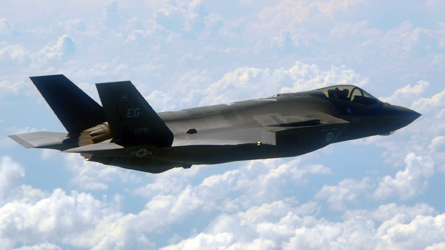The US Air Force's 33rd Fighter Wing (FW) has started training the first Air National Guard (ANG) pilot on the Lockheed Martin F-35 Joint Strike Fighter at Eglin AFB, Florida.
Maj Jay Spohn, chief of standards and evaluation at the 33rd FW's operations group and a member of the Florida Air National Guard, flew his first transition flight in the F-35A-model jet on 16 July. After five more flights, he will be qualified as an F-35 instructor pilot.
"I felt much more comfortable on my very first flight in the F-35 than I did two and half years ago on my first flight in the [Boeing] F-15C or 10 years ago on my first flight in the [Fairchild Republic] A-10," Spohn says. "I attribute that directly to the quality of training I received here at Eglin."
 |
|---|
Lt Col Eric Smith/US Air Force |
Spohn adds that the F-35 is a joy to fly. "The aircraft flies just like the simulator, which is a good thing," he says.
Having flown only one sortie and accounting for the operating restrictions on Eglin's F-35s, Spohn says he is not able to offer any meaningful opinions about the aircraft's tactical capabilities just yet. But the F-35's future capabilities, which will eventually be released to the 33rd FW, look very promising for all of the mission types he has flown before, he adds.
But even with the limited flight envelope released to Eglin for training, Spohn says that some of the F-35's characteristics are already apparent. The jet's subsonic acceleration is excellent.
"I think it compares very favourably to the F-15C," Spohn says. "I would say the acceleration in a straight line is absolutely comparable to the F-15C equipped with [Pratt & Whitney F100]-220 engines that aircraft is a pretty spy performer, if you will, and it compared very well with that."
Though pilots at the Florida base are currently only flying the most basic of training sorties, some of the instructors are starting to undertake more tactically oriented flights. "The guys who have been checked out have done some very basic tactical intercepts," Spohn says. "But obviously it's difficult to get a real feel for how the aircraft handles when you are operating within a restricted envelope like that."
Col Andrew Toth, commander of the 33rd FW, adds that those sorties are flown in one-versus-one setups with a chase aircraft. "They basically drive straight through at the merge and go to opposite points," Toth says. "No BFM [basic fighter manoeuvres]."
Meanwhile, ground crews are also finding the F-35 easy to work with compared to older machines, says Master Sgt Brian Rowlands. "It is a lot simpler than the F-15C, which is what I came off of."
Organizationally, it is significant that the ANG is getting involved with flying the F-35 this early on. Spohn is one of two ANG pilots at Eglin; the other is the wing's deputy operations group commander. There are also two US Air Force Reserves pilots assigned to the base. The pilots are not part of an ANG associate setup found at other bases, the Guard officers are fully embedded into the unit, Spohn says.
"The fact that we're in the Guard is transparent to most people," he says.
That is part of the goal of the USAF's total force integration effort-a seamless USAF with little distinction between the active, Guard and Reserve components.
Source: Flight International



















